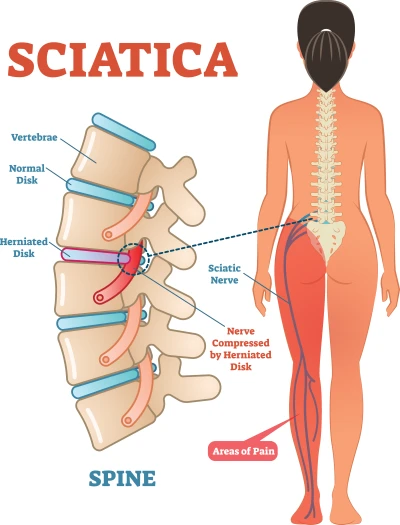The sciatic nerve is the largest nerve in the human body, so it’s not surprising that when it flares up, it feels intense.
Sciatica often results from nerve compression due to a herniated disk in the lower spine, where the pain generally starts. Sciatic pain can fluctuate in terms of how much it may affect you and typically only affects one side of the body.

Pain can radiate from the upper legs down to the feet through the glute area and seem to make your lower half throb. Sometimes you may not feel it at all, and other times it may be agonizing. Most certainly, it can affect walking, running, sports, work, and life in general.
Many people rely on medications to alleviate sciatic pain. However, physical therapy and movement, in general, can help tremendously.
Albert Kaplan DPT, offers some suggestions to help reduce your sciatic pain. If your pain is severe or becomes progressively worse, it’s time to call your doctor.
What stretches are best for relieving sciatica and sciatica-related pain?
Long answer: It's complicated.
Short answer: It's complicated.
There is no single exercise that alleviates all sciatic pain, and an exercise that alleviates one person's pain may aggravate another's. Movement tends to be the best way to alleviate sciatic pain or leg pain that originates in the spine.
For people who have pain when they sit and find relief in standing, repetitive trunk extensions may minimize sciatic pain. On the flip side, for people who find standing and walking more aggravating, repeated trunk flexion may reduce their pain.
Why is movement effective for sciatic relief?
When you feel pain or discomfort in your body, your natural response is likely to move the painful area less. Counterintuitively, movement can help reduce the pain you feel.
Movement lubricates joints and brings blood flow to muscles. Movement provides a competing neurological message that can crowd out the signal that the brain determines to be pain.
What are other movements or activities that can help relieve pain in this area?
Most movements and exercises patients find it enjoyable to do are the most effective for relieving pain. If bike riding is not your thing, then try taking a walk instead. Consistency is key.
Activity is not only good for your muscles and joints, but it also allows you to interact with friends and neighbors. Time with loved one's safeguards against the lack of social interaction and support that often happens when we feel crippling pain.
Doing a fun activity with people you enjoy may give you a brief although welcome distraction, which is a powerful tool for pain management.
What stretches are best for improving flexibility and relieving pain in the hips and lower back? How are these different (or the same) as those for sciatica?
Flexibility is something that is often misunderstood. Is your flexibility poor because your muscles have "shrunk"? Is your body trying to protect you by limiting a movement it perceives to be harmful?
Move, move, and move some more. You may be surprised how much better your range of motion becomes. Better yet, the same movements that increase your flexibility can help manage your sciatic pain.
What role does stress play in sciatica (if any)?
Think of pain like a fire and stress like gasoline. This analogy works for pain of any kind. Behavioral factors like stress, sleep, nutrition, and social support all can help or hurt how you manage your sciatica.
Frequently Asked Questions
What exercises are best for relieving sciatic pain?
There’s no single exercise for everyone. Depending on your symptoms, trunk extensions or trunk flexion may help. The key is consistent movement tailored to your body’s response.
How does movement reduce sciatic pain?
Movement lubricates joints, increases blood flow, and provides competing signals to the brain, which can help reduce the perception of pain.
Can lifestyle factors like stress affect sciatica?
Yes. Stress, sleep, nutrition, and social support all impact pain management. Reducing stress and staying active can help alleviate sciatic discomfort.
Comments
January 10, 2018
January 10, 2018
Back




January 11, 2018